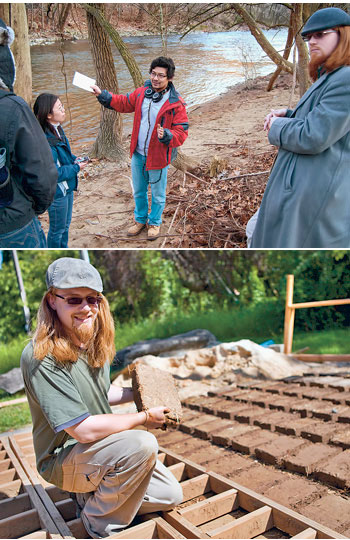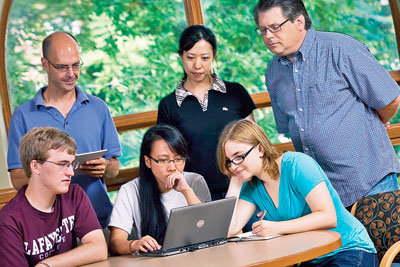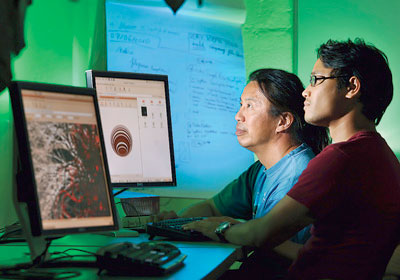Making Connections
by Stevie O. Daniels | photography by Roy Groething
Interdisciplinary activities and collaborations are being woven more tightly into the fabric of Lafayette’s academic character. Opportunities for students include 14 interdisciplinary majors, 11 interdisciplinary minors, and many special courses, such as Madagascar-Lafayette Initiative for Higher Education and Technology Clinic, which bring together students who are pursuing different majors.Students also participate in a forum dedicated to discussing interdisciplinary initiatives and in College-wide multidisciplinary projects such as Engineers Without Borders and the Economic Empowerment and Global Learning Project.
More than 230 students have chosen one of the interdisciplinary majors, and nearly all students participate in a project or take courses outside their traditional major.
Faculty collaboration on research and curricular endeavors is widespread and growing. More than 25 such projects are currently under way. These include interactions between professors in art and neuroscience, biology and computer science, economics and mathematics, music and psychology, and chemical engineering and chemistry, to name a few.

Sandy Ma ’13 (L-R), Ritesh Maharjan ’13, and Sam Strong ’12, part of a multidisciplinary team of students advised by professors in art and engineering, discuss a location for the miniature clay ziggurat they are creating as an environmental sculpture for the Karl Stirner Arts Trail along Bushkill Creek.
Seven new faculty members have been hired in interdisciplinary positions. The College changed its hiring and tenure policies to encourage and support faculty in their efforts to offer students interdisciplinary learning experiences in any department and in any field. Indeed Lafayette is a national leader in developing and implementing guidelines and standards for hiring faculty in joint departmental or interdisciplinary positions.
“A lot of institutions merely wish for interdisciplinary teaching and learning,” says Associate Professor Mary Armstrong, who joined the College in 2009 in a joint appointment in the women’s and gender studies program and the English department. “Lafayette has worked to achieve this, investing real time, commitment, and resources. The quality and depth of our interdisciplinary programs evidence that leadership and vision.”
The strength of an interdisciplinary approach is that it reflects the real world in all of its complexity. “Exposing students to interdisciplinary perspectives is one of the key ways to enable them to see how solving difficult issues requires the sustained and cooperative efforts of many knowledgeable people from many different places,” says Armstrong.
For example, the content of courses in women’s and gender studies is interdisciplinary by nature, says Armstrong, who chairs WGS, because “in order to understand phenomena related to gender, you need a lot of analytical tools, as well as the insights that come from different disciplines. Gender is too complicated, and too important, to be looked at from only one analytical perspective.”

Members of an environmental policy project team include
(clockwise from left) Christopher Jones ’13, computer science;
Chris Ruebeck, associate professor of economics; Laura Wong
Hon Chan ’12, economics; Jeff Pfaffmann, assistant professor of computer science; Shannon Sullivan ’13, psychology, and Phuong Anh Nguyen ’12, international economics and commerce.
Other interdisciplinary programs share that same inherent crossing of disciplines. “A profound understanding of antiquity requires knowledge in the ancient languages, history, philosophy, sciences, literature, and art,” says Markus Dubischar, associate professor of classics and coordinator of the classical civilization minor. “In addition many modern disciplines in the sciences and humanities have their roots in Greece or Rome. Students can best explore this vast field of cultural influences, relations, and traditions on a campus like Lafayette’s where academic disciplines are not pigeonholed but instead are engaged in constant vibrant interdisciplinary dialogues.”
HIGH IMPACT
Numerous studies have shown that interdisciplinarity enhances student learning, improving both creative thinking and critical thinking. A culture of collaboration benefits faculty as well.
“Fostering an interdisciplinary approach is consistent with the history and mission of liberal arts colleges, which is to make connections,” says Provost Wendy Hill. “It helps students broaden their perspective beyond their major and helps the College move away from the historical vestige of placing attention only on individual work.”
Chris Ruebeck, professor of economics, who has been involved in collaborative projects inside and outside the classroom and across multiple divisions of the College, agrees. “A signature characteristic of Lafayette is that interdisciplinarity has been valued, and the support continues to grow, not only through informal channels but formal ones as well. Faculty at a small college must be more interdisciplinary in all they do. We rub shoulders with a more diverse group of colleagues on a regular basis than do our counterparts at larger institutions. We are thus stronger role models for our students in these efforts.”

Chun Wai Liew (left), associate professor of computer science,
works with Ashutosh Tamraker ’12 on a project for the course Modeling-Based Applications to Biology that combines biology and computer science and is co-taught with Robert Kurt, associate professor of biology.
Armstrong and Chun Wai Liew, associate professor of computer science, organized a forum to facilitate faculty discussion of issues related to teaching interdisciplinary courses. A similar series gives students an opportunity to describe their collaborations.
“Challenges come with interdisciplinary work,” says Ruebeck. “Work, that is, in which we avoid watering down any discipline; work where we instead use the deep knowledge of each discipline to enhance the other’s (or others’) understanding and application.”
For example, the client for a project in Ruebeck’s course on Marketing Research was Easton’s West Ward neighborhood. To better serve the client and to enhance the learning experience for his students, he worked with Crystal Fortwangler, then Mellon Postdoctoral Fellow in environmental studies, and the students in her course on Food, Culture, and Sustainable Societies.
Ruebeck’s course was focused on quantitative methods. Fortwangler, an anthropologist, joined the project to give her students experience in qualitative data collection. For his students, Ruebeck says, working with “another social scientist using a different method was a great advantage. By thinking about, listening to, and collaborating with the anthropology students, my class learned more about the qualitative method than we could have otherwise.”
At Lafayette, Armstong says, students don’t have to go looking for an interdisciplinary opportunity, “INDS is fully integrated into the curriculum and, hopefully, will be a natural part of every student’s experience here.”